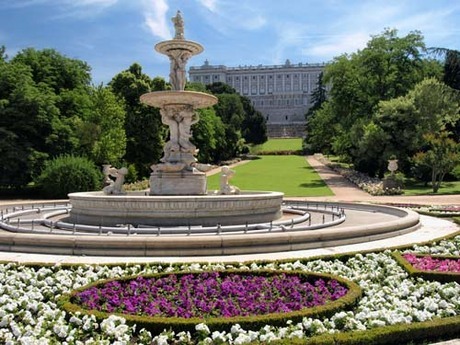Campo del Moro Gardens
Madrid has been called a “green” city. This is because there are several wide-open spaces in the form of parks and gardens where one can take in the beautiful and verdant colors of nature. One such space is the Campo del Moro Gardens. Open from 10 AM until 6 PM, these are Royal gardens, as evidenced by their location down the hill from Madrid’s Royal Palace. You have two wonderful views in one from both the palace and the gardens.
You will be able to stroll through many varieties of trees, such as magnolia, boxwood, and cedar. Sit beside the fountain in the Campo del Moro Gardens, and enjoy the sights and sounds around you. Admire the gorgeous peacocks, and come prepared to feed the many ducks at the duck pond. Find a discount hotel near Campo del Moro Gardens in Madrid within walking distance of all of this natural beauty.
These gardens are named after allegedly camped in this place the troops of the Muslim leader Ali ben Yusuf in 1109 during an attempted reconquest of Madrid.
The first works to condition the area are due to Philip IV, whose reign it were built fountains and planted different kinds of vegetation, but the overall look of the place remained largely neglected. During the construction of the new palace were various landscaping projects based in the gardens of the Royal Palace of La Granja de San Ildefonso, but there was no doing anything due the lack of funds, not being until the reign of Isabel II in which started a landscaping more seriously.
At this time it design a big park of Romanticist style and were installed fountains brought from the Royal Palace of Aranjuez. With the fall of Isabel II the gardens suffer a period of abandonment and neglect in which it lose a part of the design and not until the regency of Maria Christina of Austria when it began a series of rehabilitation works, giving the current design, which follows the layout of the English gardens of 19th century.
From time to time throughout his reign, for example to hold his saint day of Saint John, King Juan Carlos has held receptions and gala dinners in the gardens during the summer months.
Before the construction of the formal park on this spot there was a profusely wooded space where royalty used to hunt small game. Also, it was an area from where people used to go to the Casa de Campo, another famous Madrid green space. In the 18th Century, when the old palace burned down, Felipe IV commissioned the construction of a new modern and imposing building and a garden. This park was not well cared for nor well developed due to lack of sufficient finances. It was a formal park that ornamented the Palace until the 19th Century (1844), when Queen Isabel II decided to make it a garden-park worthy of such a magnificent royal residence. During her reign, the park was refurbished to a great extent with many structures added to it such as spectacular fountains: the Fountain of the Tritons and of the Shells, as well as the Triada of the palace of Aranjuez. Those two fountains do not only embellish the area but also establish the central axis of the garden with the right alleys that cross it. The design from the epoch of Isabel II also included beautiful geometrically arranged parterres - but all this was abandoned after her death.
Certain renovation works and reformation of the overall layout of the Campo del Moro were undertaken under the regency of Maria Cristina at the end of the 19th Century and the main features of this redevelopment have been kept to this day. At the time, the park was landscaped in the English fashion with curving alleys and open spaces with trees. The reshaping in this romantic style, however, did not terminate the emblematic two fountains and their right alleys. As a result, the present state of Campo del Moro’s layout is influenced by both styles, which make it even more attractive for a visit. Moreover, the arboreal variety ranges over 70 species, including elms, oaks and other types of trees – some more than 170 years old.
Campo del Moro has a lot to offer to its visitors: the rich flora that radiates peace and quiet, as well as a sense of being in the presence of art and culture. Special sights of interest in the park are the two fountains of the Tritons and of the Shells, among the other structures on the park’s premises. An interesting fact is that the Royal Palace is also called the Eastern Palace (because it is not used as the royal residence but can be accessed by the public if not used for official state gatherings.) Another unique feature of Campo del Moro is the iron wall that surrounds the park and the iron door through which visitors enter. You can get there via flight to Madrid.



